Assessment of a Simplified Connectivity Index and Specific Sediment Potential in River Basins by Means of Geomorphometric Tools
Abstract
1. Introduction
2. Materials and Methods
2.1. Basic Concept
- SLi is the specific soil loss from the ith unit area;
- SLmax is maximum specific soil loss;
- di is distance of the ith unit area from the outlet;
- dmax is maximum distance from the outlet;
- N is the total number of unit areas.
2.2. Available GIS Tools
3. Results and Discussion
4. Conclusions
Acknowledgments
Author Contributions
Conflicts of Interest
References
- Wischmeier, W.H.; Smith, D.D. Predicting rainfall erosion losses—A guide to conservation planning. In US Department of Agriculture, Agriculture Handbook No. 537; US Government Printing Office: Washington, DC, USA, 1978. [Google Scholar]
- Renard, K.G.; Foster, G.R.; Weesies, G.A.; Porter, J.P. RUSLE—Revised universal soil loss equation. J. Soil Water Conserv. 1991, 46, 30–33. [Google Scholar]
- Renard, K.G.; Foster, G.R.; Weesies, G.A.; McCool, D.K.; Yoder, D.C. Predicting soil erosion by water—A guide to conservation planning with the revised universal soil loss equation (RUSLE). In US Department of Agriculture, Agriculture Handbook No. 703; US Government Printing Office: Washington, DC, USA, 1997. [Google Scholar]
- Wolman, M.G. Changing needs and opportunities in the sediment field. Water Resour. Res. 1977, 13, 50–54. [Google Scholar] [CrossRef]
- Walling, D.E. The sediment delivery problem. J. Hydrol. 1983, 65, 209–237. [Google Scholar] [CrossRef]
- Ferro, V.; Minacapilli, M. Sediment delivery processes at basin scale. Hydrol. Sci. J. 1995, 40, 703–717. [Google Scholar] [CrossRef]
- Dedkov, A. The relationship between sediment yield and drainage basin area. In Sediment Transfer through the Fluvial System, Proceedings of the International Symposium Held in Moscow, Russia, 2–6 August 2004; IAHS Publications: Wallingford, UK, 2004. [Google Scholar]
- Lu, H.; Moran, C.; Prosser, I.; Sivapalan, M. Modelling sediment delivery ratio based on physical principles. In Proceedings of the 2nd International Congress on Environmental Modelling and Software, Osnabrück, Germany, 14–17 June 2004. [Google Scholar]
- Lenhart, T.; Van Rompaey, A.; Steegen, A.; Fohrer, N.; Frede, H.-G.; Govers, G. Considering spatial distribution and deposition of sediment in lumped and semi-distributed models. Hydrol. Process. 2005, 19, 785–794. [Google Scholar] [CrossRef]
- Diodato, N.; Grauso, S. An improved correlation model for sediment delivery ratio assessment. Environ. Earth Sci. 2009, 59, 223–231. [Google Scholar] [CrossRef]
- Vigiak, O.; Borselli, L.; Newham, L.T.H.; McInnes, J.; Roberts, A.M. Comparison of conceptual landscape metrics to define hillslope-scale sediment delivery ratio. Geomorphology 2012, 138, 74–88. [Google Scholar] [CrossRef]
- Hooke, J. Coarse sediment connectivity in river channel systems: A conceptual framework and methodology. Geomorphology 2003, 56, 79–94. [Google Scholar] [CrossRef]
- Pilotti, M.; Bacchi, B. Distributed evaluation of the contribution of soil erosion to the sediment yield from a watershed. Earth Surface Process. Landf. 1997, 22, 1239–1251. [Google Scholar] [CrossRef]
- Cammeraat, L.H. A review of two strongly contrasting geomorphological systems within the context of scale. Earth Surface Process. Landf. 2002, 27, 1201–1222. [Google Scholar] [CrossRef]
- Masselink, R.J.H.; Heckmann, T.; Temme, A.J.A.M.; Anders, N.S.; Gooren, H.P.A.; Keesstra, S.D. A network theory approach for a better understanding of overland flow connectivity. Hydrol. Process. 2017, 31, 207–220. [Google Scholar] [CrossRef]
- Fryirs, K.A.; Brierley, G.J.; Preston, N.J.; Spencer, J. Catchment-scale (dis)connectivity in sediment flux in the upper Hunter catchment, New South Wales, Australia. Geomorphology 2007, 84, 297–316. [Google Scholar] [CrossRef]
- Gumiere, S.J.; Le Bissonnais, Y.; Raclot, D.; Cheviron, B. Vegetated filter effects on sedimentological connectivity of agricultural catchments in erosion modelling: A review. Earth Surface Process. Landf. 2011, 36, 3–19. [Google Scholar] [CrossRef]
- López-Vicente, M.; Nadal-Romero, E.; Cammeraat, L.H. Hydrological connectivity does change over 70 years of abandonment and afforestation in the Spanish Pyrenees. Land Degrad. Dev. 2016, 28, 1298–1310. [Google Scholar] [CrossRef]
- Borselli, L.; Cassi, P.; Torri, D. Prolegomena to sediment and flow connectivity in the landscape: A GIS and field numerical assessment. Catena 2008, 75, 268–277. [Google Scholar] [CrossRef]
- Cavalli, M.; Trevisani, S.; Comiti, F.; Marchi, L. Geomorphometric assessment of spatial sediment connectivity in small Alpine catchments. Geomorphology 2013, 188, 31–41. [Google Scholar] [CrossRef]
- Brardinoni, F.; Cavalli, M.; Heckmann, T.; Liébault, F.; Rimböck, A. Guidelines for Assessing Sediment Dynamics in Alpine Basins and Channel Reaches. Available online: http://www.sedalp.eu/download/dwd/reports/WP4_Report.pdf (accessed on 6 November 2017).
- López-Vicente, M.; Álvarez, S. Influence of DEM resolution on modelling hydrological connectivity in a complex agricultural catchment with woody crops. Earth Surface Process. Landf. 2017. [Google Scholar] [CrossRef]
- Cantreul, V.; Bielders, C.; Calsamiglia, A.; Degré, A. How pixel size affects a sediment connectivity index in central Belgium. Earth Surface Process. Landf. 2017. [Google Scholar] [CrossRef]
- López-Vicente, M.; Poesen, J.; Navas, A.; Gaspar, L. Predicting runoff and sediment connectivity and soil erosion by water for different land use scenarios in the Spanish Pre-Pyrenees. Catena 2013, 102, 62–73. [Google Scholar] [CrossRef]
- López-Vicente, M.; Quijano, L.; Palazón, L.; Gaspar, L. Assessment of soil redistribution at catchment scale by coupling a soil erosion model and a sediment connectivity index (Central Spanish Pre-Pyrenees). Cuad. Investig. Geogr. 2015, 141, 127–147. [Google Scholar] [CrossRef]
- Cammeraat, L.H.; van Beek, L.P.H.; Dooms, T. Modelling Water and Sediment Connectivity Patterns in a Semi-Arid Landscape. Available online: https://pure.uva.nl/ws/files/1083710/71066_murcia.pdf (accessed on 6 November 2017).
- Sklar, L.S.; Riebe, C.S.; Lukens, C.E.; Bellugi, D. Catchment power and the joint distribution of elevation and travel distance to the outlet. Earth Surface Dyn. 2016, 4, 799–818. [Google Scholar] [CrossRef]
- Heckmann, T.; Schwanghart, W. Geomorphic coupling and sediment connectivity in an alpine catchment—Exploring sediment cascades using graph theory. Geomorphology 2013, 182, 89–103. [Google Scholar] [CrossRef]
- Cossart, É.; Fressard, M. Assessment of structural sediment connectivity within catchments: Insights from graph theory. Earth Surface Dyn. 2017, 5, 253–268. [Google Scholar] [CrossRef]
- Heckmann, T.; Vericat, D. Inferring sediment connectivity from high-resolution DEMs of Difference. In Proceedings of the European Geosciences Union General Assembly 2017, Vienna, Austria, 23–28 April 2017. [Google Scholar]
- SedAlp Project. Sediment Management in Alpine Basins. Available online: http://www.sedalp.eu/project/ (accessed on 6 November 2017).
- Connecteur Project. Connecting European Connectivity Research (COST Action No. ES1306). Available online: http://connecteur.info/ (accessed on 6 November 2017).
- Crema, S.; Cavalli, M. SedInConnect: A stand-alone, free and open source tool for the assessment of sediment connectivity. Comput. Geosci. 2018, 111, 39–45. [Google Scholar] [CrossRef]
- Panagos, P.; Borrelli, P.; Poesen, J.; Ballabio, C.; Lugato, E.; Meusburger, K.; Montanarella, L.; Alewell, C. The new assessment of soil loss by water erosion in Europe. Environ. Sci. Policy 2015, 54, 438–447. [Google Scholar] [CrossRef]
- Lane, L.J.; Hernandez, M.; Nichols, M. Processes controlling sediment yield from watersheds as functions of spatial scale. Environ. Model. Softw. 1997, 12, 355–369. [Google Scholar] [CrossRef]
- Verstraeten, G.; Poesen, J. Factors controlling sediment yield from small intensively cultivated catchments in a temperate humid climate. Geomorphology 2001, 40, 123–144. [Google Scholar] [CrossRef]
- Verstraeten, G.; Poesen, J.; de Vente, J.; Koninckx, X. Sediment yield variability in Spain: A quantitative and semiqualitative analysis using reservoir sedimentation rates. Geomorphology 2003, 50, 327–348. [Google Scholar] [CrossRef]
- De Vente, J.; Poesen, J. Predicting soil erosion and sediment yield at the basin scale: Scale issues and semi-quantitative models. Earth-Sci. Rev. 2005, 71, 95–125. [Google Scholar] [CrossRef]
- QGIS. A Free and Open Source Geographic Information System. Available online: http://www.qgis.org/ (accessed on 6 November 2017).
- Neteler, M.; Bowman, M.H.; Landa, M.; Metz, M. GRASS GIS: A multi-purpose open source GIS. Environ. Model. Softw. 2012, 31, 124–130. [Google Scholar] [CrossRef]
- Tebano, C.; Pasanisi, F.; Grauso, S. QMorphoStream: Processing tools in QGIS environment for the quantitative geomorphic analysis of watersheds and river networks. Earth Sci. Inf. 2017, 10, 257–268. [Google Scholar] [CrossRef]
- National Geoportal. Access Point to Environmental and Territorial Information. Available online: http://www.pcn.minambiente.it/mattm/en/ (accessed on 6 November 2017).
- Hadley, R.; Schumm, S. Sediment sources and drainage basin characteristics in upper cheyenne river basin. In US Geological Survey, Water Supply Paper No. 1531-B; US Government Printing Office: Washington, DC, USA, 1961. [Google Scholar]
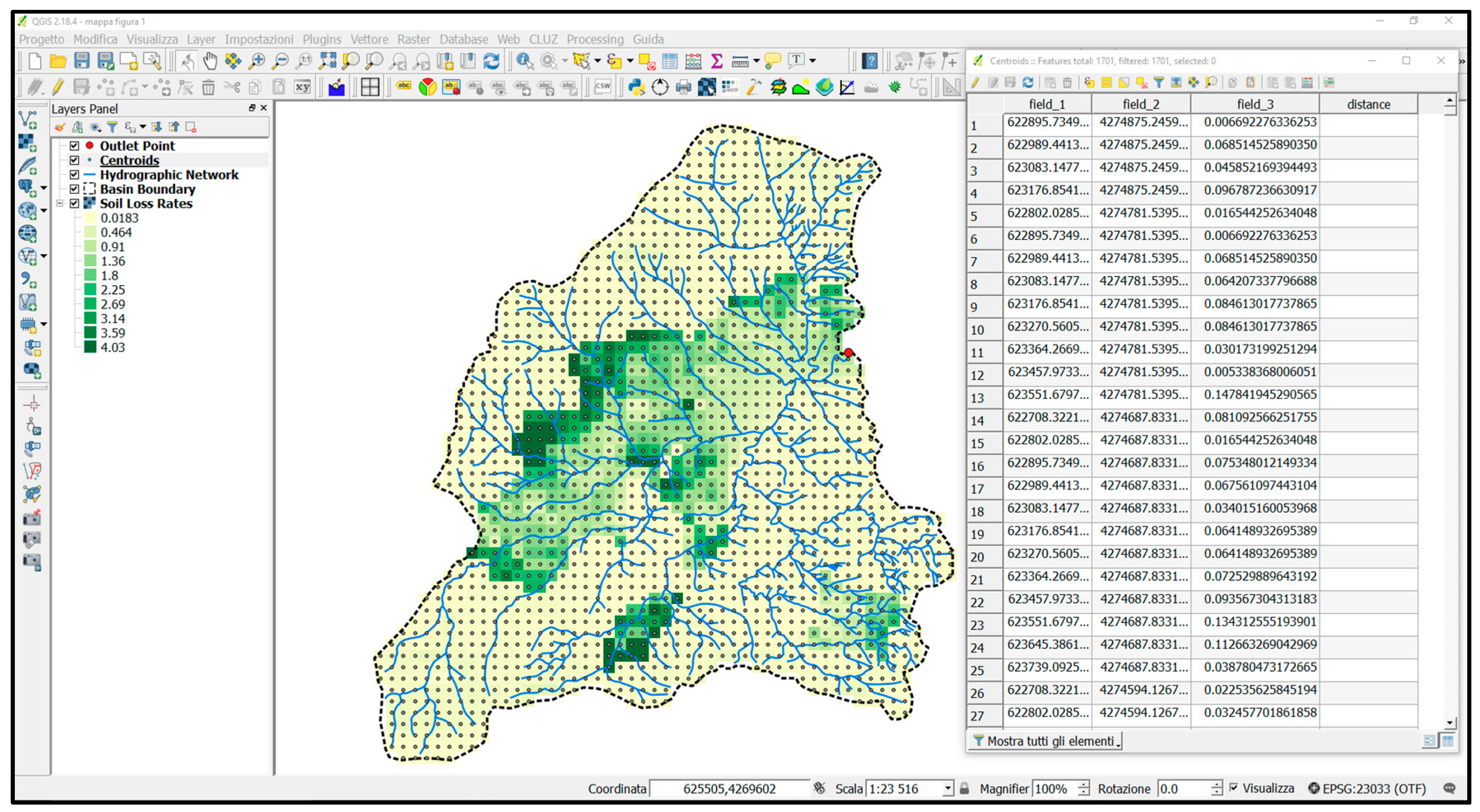

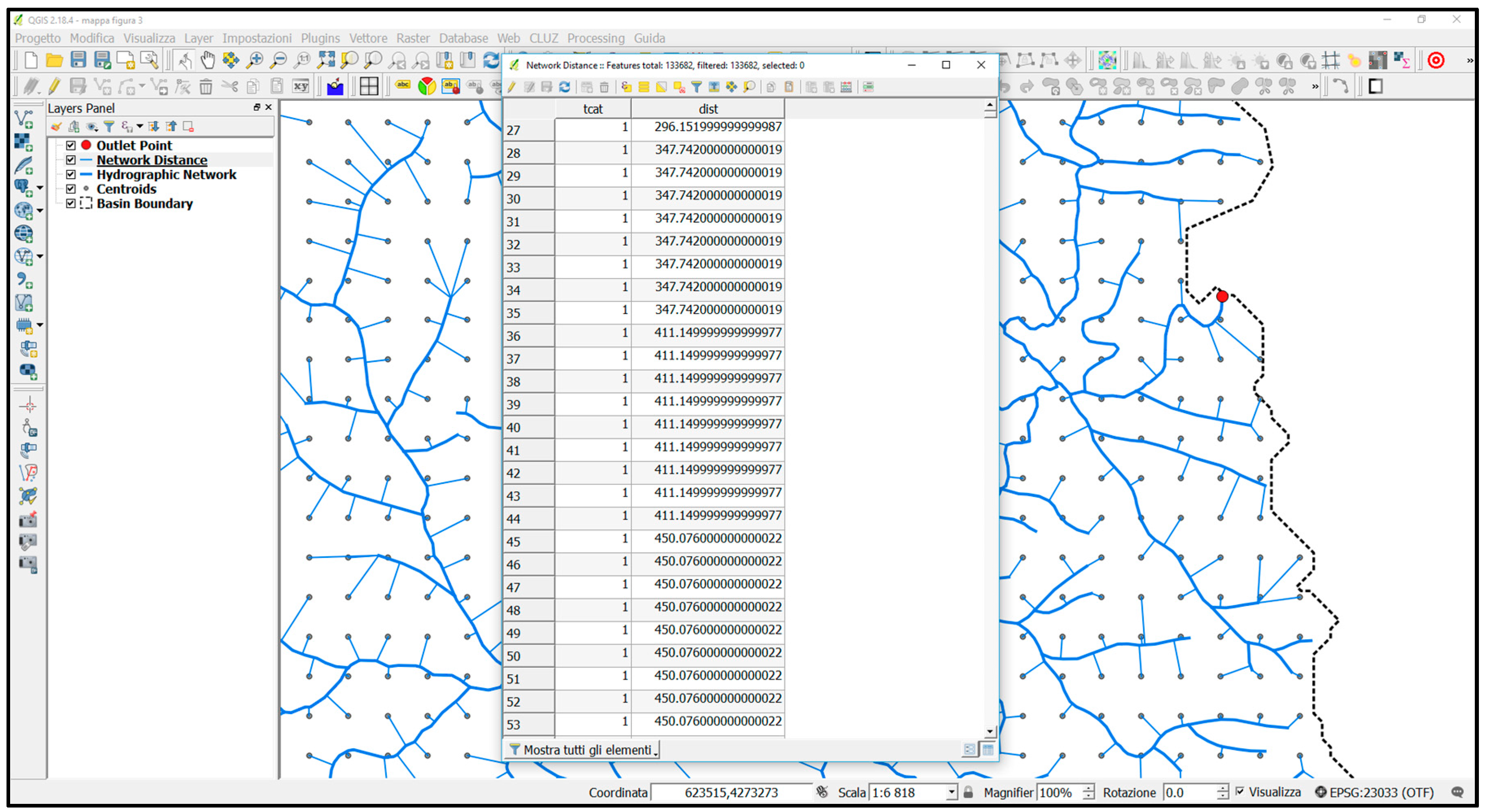
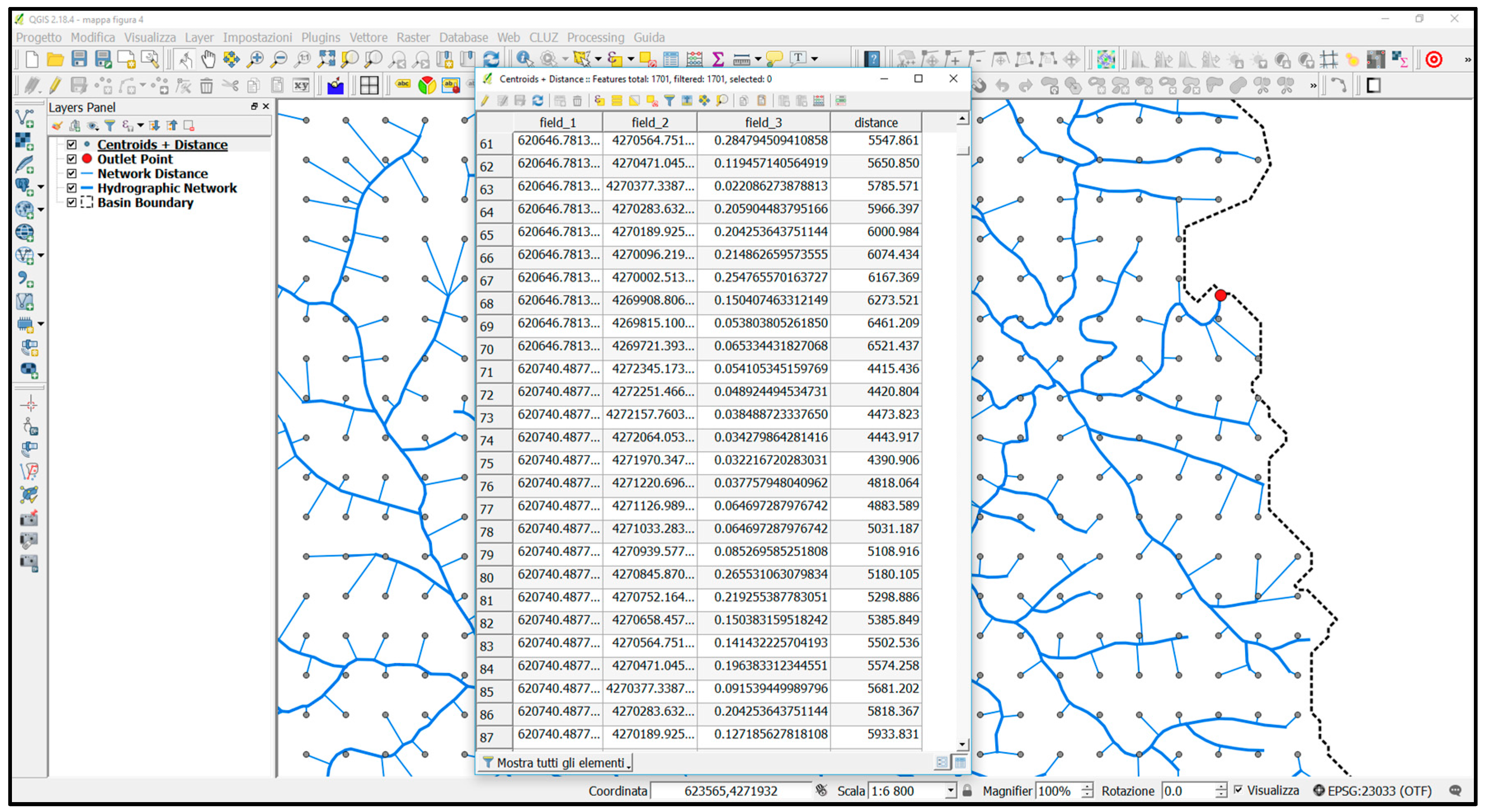
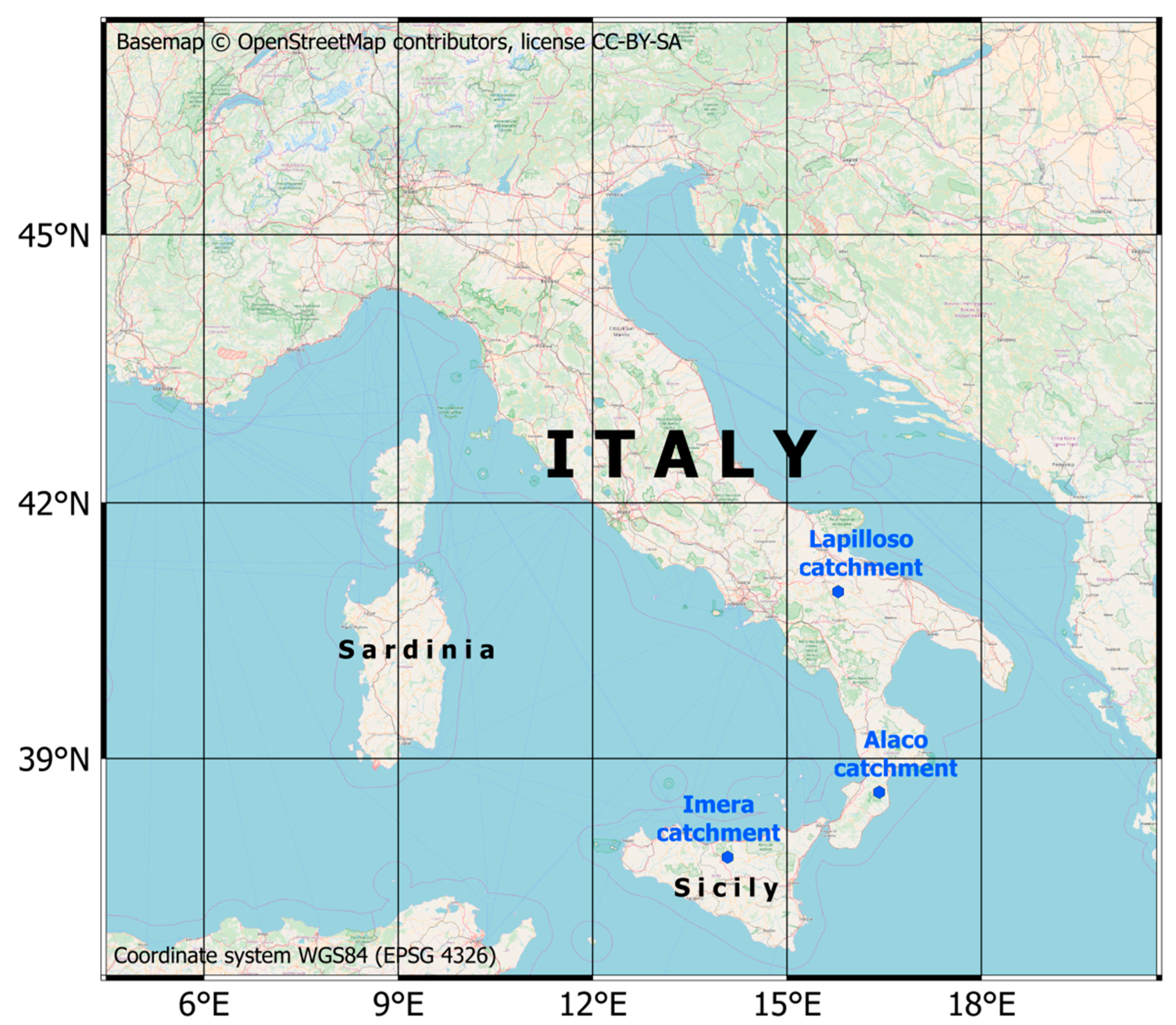
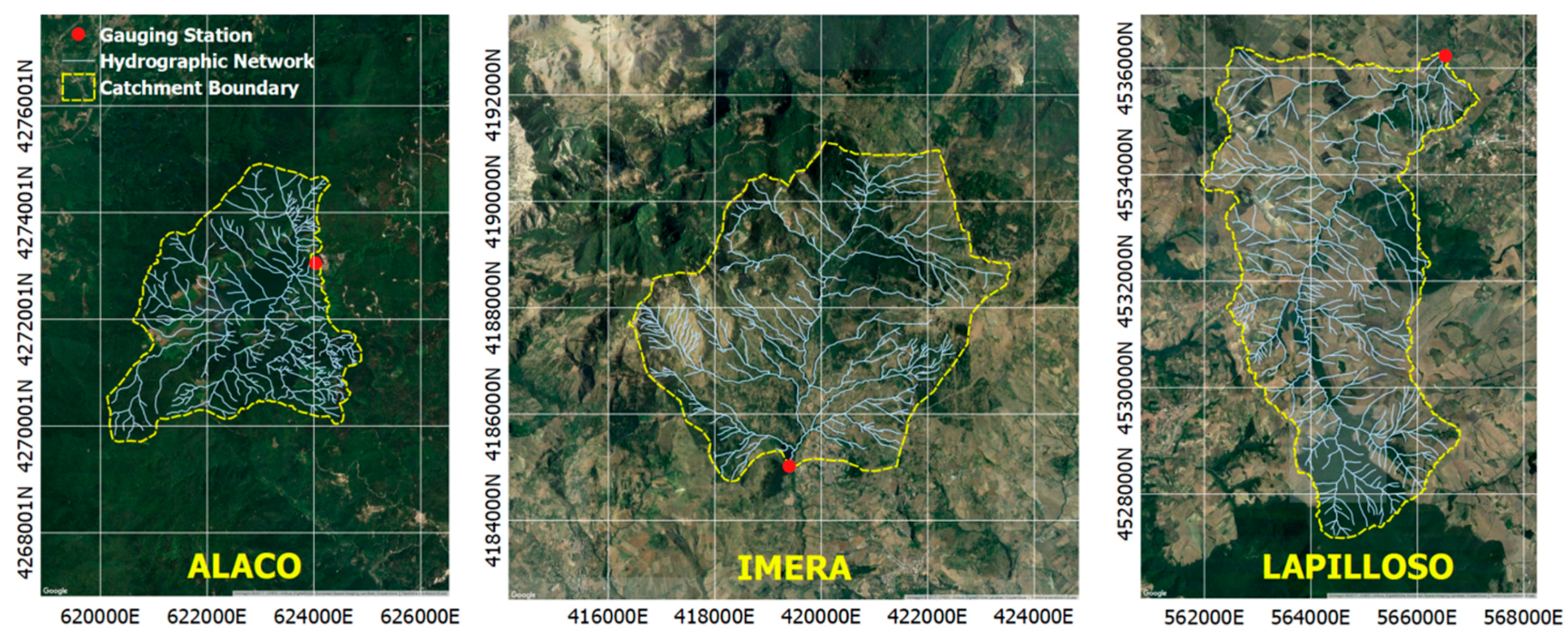
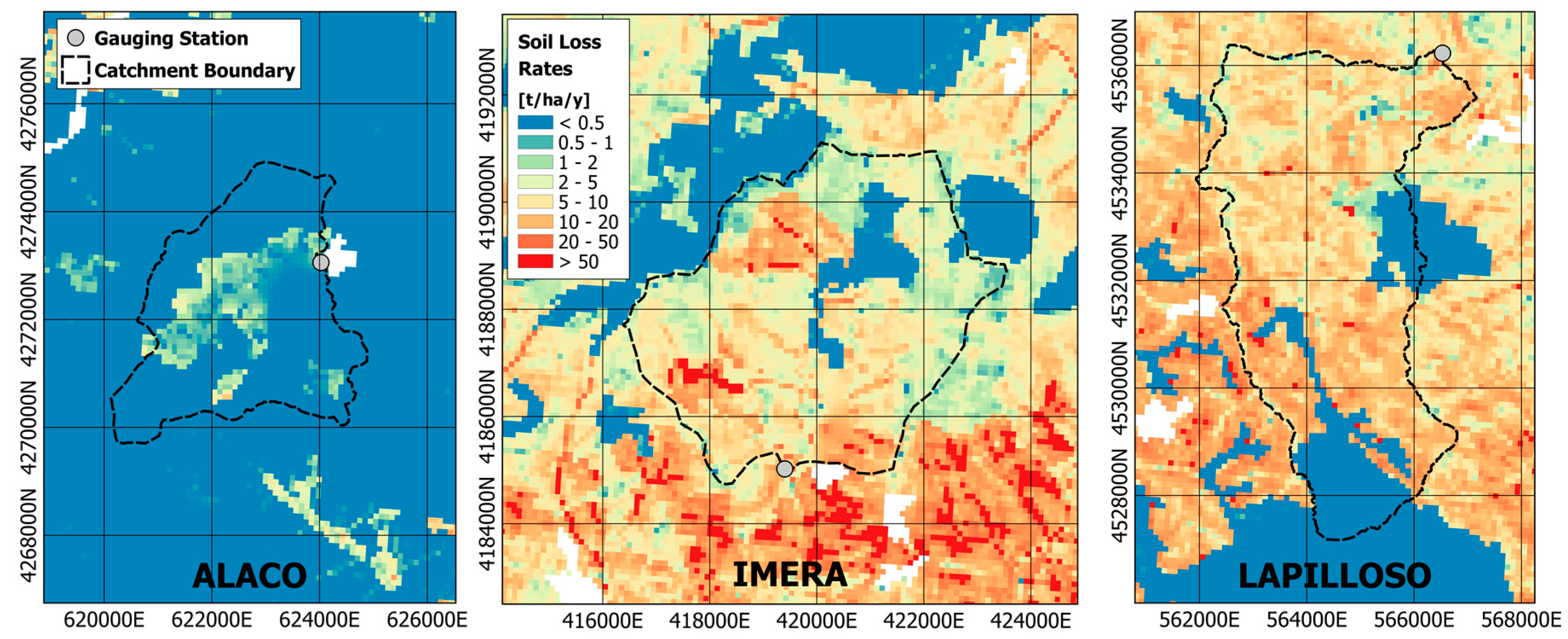
| Physical Characters | Alaco | Lapilloso | Imera |
|---|---|---|---|
| Perimeter (km) | 19.4 | 31.3 | 22.9 |
| Area (km2) | 14.9 | 28.9 | 28.5 |
| Max elevation (m above sea level) | 1259 | 815 | 1826 |
| Min elevation (m a.s.l.) | 971 | 305 | 798 |
| Mean elevation (m a.s.l.) | 1048 | 554 | 1226 |
| Elevation Range (m) | 288 | 510 | 1028 |
| Max elongation (km) | 5.0 | 9.3 | 6.6 |
| Streams’ total length (km) | 92.9 | 141.6 | 117.7 |
| Stream frequency (km−2) | 22.7 | 10.9 | 10.1 |
| Drainage density (km−1) | 6.22 | 4.90 | 4.13 |
| Fournier’s orographic coeff. | 0.073 | 0.011 | 0.053 |
| Hypsometric integral | 0.295 | 0.413 | 0.390 |
| Circularity ratio | 0.497 | 0.370 | 0.679 |
| Relief ratio | 0.250 | 0.088 | 0.278 |
| Elongation ratio | 0.867 | 0.652 | 0.918 |
| Catchment Quantities and Indices | Alaco | Lapilloso | Imera |
|---|---|---|---|
| SL (ha−1·y−1) | 0.59 | 13.60 | 11.39 |
| SCI | 1.05 | 0.25 | 0.74 |
| SSP (t·ha−1·y−1) | 0.615 | 14.28 | 13.18 |
| d (km) | 3.40 | 7.12 | 4.65 |
| SSY (t·ha−1·y−1) | 0.703 | 0.337 | 1.915 |
| SDR | 1.05 | 0.03 | 0.15 |
© 2018 by the authors. Licensee MDPI, Basel, Switzerland. This article is an open access article distributed under the terms and conditions of the Creative Commons Attribution (CC BY) license (http://creativecommons.org/licenses/by/4.0/).
Share and Cite
Grauso, S.; Pasanisi, F.; Tebano, C. Assessment of a Simplified Connectivity Index and Specific Sediment Potential in River Basins by Means of Geomorphometric Tools. Geosciences 2018, 8, 48. https://doi.org/10.3390/geosciences8020048
Grauso S, Pasanisi F, Tebano C. Assessment of a Simplified Connectivity Index and Specific Sediment Potential in River Basins by Means of Geomorphometric Tools. Geosciences. 2018; 8(2):48. https://doi.org/10.3390/geosciences8020048
Chicago/Turabian StyleGrauso, Sergio, Francesco Pasanisi, and Carlo Tebano. 2018. "Assessment of a Simplified Connectivity Index and Specific Sediment Potential in River Basins by Means of Geomorphometric Tools" Geosciences 8, no. 2: 48. https://doi.org/10.3390/geosciences8020048
APA StyleGrauso, S., Pasanisi, F., & Tebano, C. (2018). Assessment of a Simplified Connectivity Index and Specific Sediment Potential in River Basins by Means of Geomorphometric Tools. Geosciences, 8(2), 48. https://doi.org/10.3390/geosciences8020048




